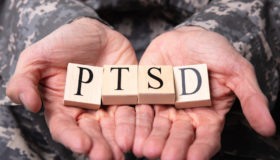The 5 W’s of PTSD
June 9, 2016
June is PTSD awareness month. At Soldiers’ Angels, we support our soldiers both at home and abroad. Many of today’s veterans are affected by or have suffered through PTSD: 31% of Vietnam veterans, 10% of Desert Storm veterans, 11% of veterans of the war in Afghanistan and 20% of veterans of the war in Iraq. We will support them today by spreading awareness. Here are some things you may not have known about Post Traumatic Stress Disorder in the form of the good old fashioned Five W’s: who, what, where, when, and why.
Who is affected by PTSD?
The short answer is, unfortunately, anyone. Anyone can suffer from PTSD—any age, creed, or nationality.Most commonly, PTSD is associated with those who have served in combat and survivors of sexual or physical assault. However, PTSD doesn’t only affect those who were in physical danger. Sometimes a loved one in danger or a sudden death of a loved one can cause PTSD.
What exactly is PTSD?
The news and popular media—TV shows, movies, games—portray Post Traumatic Stress Disorder as a dramatic affliction that oftentimes goes away with little effort. But, what is it in reality? As defined by theMayo Clinic, “PTSD is a mental health condition that’s triggered by a terrifying event—either experiencing it or witnessing it.” There are also differentlevels of intensity. One person’s symptoms could present as aggression, irritability, and trouble concentrating while another person could have more inward symptoms—memories of the event, avoidance, or suicidal thoughts.
Where can you get diagnosed or treated for PTSD?
There are a variety of professionals equipped to diagnose and treat PTSD. If you suspect you may have PTSD, fill outthis questionnaire by the Anxiety and Depression Association of America and bring your answers to a mental health professional. Where do you find this professional? The Veterans Association provides aPTSD Consultation Program free of charge.
When did PTSD come about?
This combination of symptoms has only had a name forthe past thirty-six years. PTSD first appeared as an official diagnosis in 1980 when the American Psychiatric Association added PTSD the third edition of its Diagnostic and Statistical Manual of Mental Disorders. But, as the National Center for PTSD notes, “Exposure to traumatic experiences has always been a part of the human condition. Attacks by saber tooth tigers or twenty-first century terrorists have likely led to similar psychological responses in survivors of such violence.” PTSD has been around for as long as there has been trauma.
Why do some people get it and others don’t?
PTSD is more common than you think. According to theBrain and Behavior Research Foundation, as many as five million American adults suffer from PTSD in a given year. The same article also sites that those who are more resilient to trauma tend to have a strong network of support, they are able to act effectively in the face of fear, they stay physically fit, and are able to rely upon their own moral compass.


